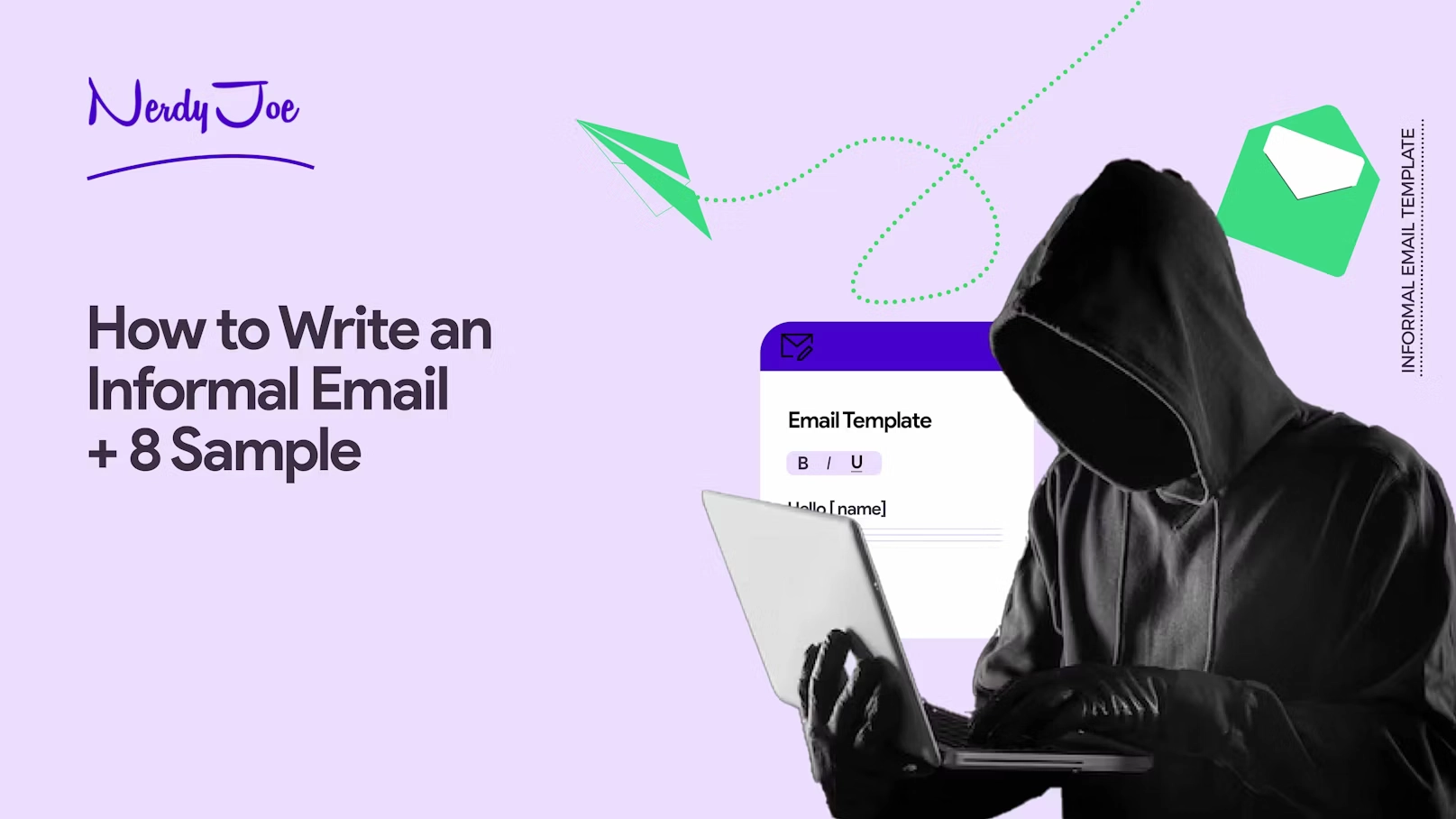Cold emailing is an effective way to reach out to potential customers and promote your products or services.
It can be a powerful tool for sales, but it’s important to approach it in the right way.
A well-written cold email can help you establish a connection with potential customers and convince them to learn more about your product or service.
However, crafting the perfect cold email takes strategy, planning, and attention to detail.
In this blog post, we’ll provide tips and best practices on how to write a cold email that we have perfected at Nerdy Joe over the years.
We’ll also discuss why sending cold emails isn’t just about making money; it’s also about building relationships with potential customers who might become long-term clients.
To keep in mind: This is not a blog post to read if you want to send cold emails to a sales list or blast your audience with random offers.
We believe every prospect has unique needs, and therefore two prospects shall not receive the same message.
Note: Struggling to get replies or book meetings with prospects that fit in your ICP? We’ll help you get 6 SQLs or book 6 meetings with prospects that are ready to buy for only $999/month. Book a 15-minute consultation now.
Why sending cold emails is not just about making money
Conducting a cold email campaign can be a way for businesses to generate leads and make money, but it’s not the only reason to send them.
Cold emails can also be used to establish connections and build relationships with potential clients or partners, gather market research and customer feedback, and promote events or products.
You should approach cold emailing with a clear strategy and goals in mind. Simply sending emails in the hopes of making a quick sale is unlikely to be effective, as it can come across as spammy or aggressive.
Also, sometimes, it can take a few follow-ups and cold email sequences to see any substantial results.
So, instead of rushing prospects into deals — they’ll probably ignore it — focus on building genuine connections with them and offering value through the content of your cold emails.
It’s also important to remember that cold emailing can be time-consuming and may not always yield results.
It’s important to track your results and adjust your approach as needed to ensure that your efforts are paying off.
10 steps to write cold emails that generate sales
Here are the steps you need to take to write an excellent cold email that generates sales. Keep in mind that this is the process we follow to write our cold emails at Nerdy Joe.
Step 1: Create click-worthy cold email subject lines
The cold email subject line is the first thing the reader will see, so it’s important to make it compelling. You want to grab the reader’s attention and make them want to open the email.
Great cold email subject lines should be brief, specific, and relevant to the reader. Here are a few tips on how to write compelling subject lines for your cold emails.
- Personalize it: The first element that gets your email opened is the relevance of the subject line to the prospects. Personalized subject lines are 22% more likely to be opened than generic ones. Poorly written subject line will leave your email unanswered.
You need to show prospects that you researched and targeted them with a specific offer. You can personalize the subject line with prospects’ first names based on their job title, demographics, software uses, etc.
- Use the power of curiosity: Curiosity makes your prospects want to discover more. It gets them excited about what you want to say, and they will likely click. There are many ways you can do this. You can ask an intriguing question. Bring out a relevant fact. The sky’s the limit.
- Leverage FOMO: Since you are making an offer, you can also try creating a sense of urgency to get your prospects to act rapidly. If you do it right, people will click to see what you have to say or offer them. No one likes to miss out on something valuable.
- Keep it simple: Don’t use all caps, and don’t use exclamation points (unless you’re asking someone out on a date). These are quick ways to get your emails flagged by spam filters and end up in the junk box.
- Keep it short: Long subject lines never do well. Also, long subject lines always have a poor rendering in most recipients’ email box providers (especially if they use mobile devices).
- Make it make sense: Sometimes, to be brief, you may want to try the subject with a few words. It can be a great idea, but mostly they’re evasive and vague, and as a result, the recipient fails to understand them.
- Use no emojis: Emojis are off-limits. While they can be a helpful way to add personality and emotion to your subject lines, they are not always appropriate in all contexts. In some cases, they may not be clear or may be interpreted differently by different people. Also, they can be too casual for cold emails.
Step 2: Commence the cold email with an icebreaker
You are probably wondering, icebreakers, what are those?
Most marketers and sales reps start their cold emails with simple greeting opening lines. That means the phrases they use to open the email fall somewhere between the realms of the following:
- Allow me to introduce myself.
- Good afternoon.
- Good morning.
- How are you?
- I hope this email finds you well.
- I hope you enjoyed your weekend.
- I hope you’re doing well.
- I hope you’re having a great week.
Some even take it a little further, and include the prospect’s first name somewhere in the line, then call it personalized greetings.
- How are you, Ibrahim?
- I hope this email finds you well, Ernest.
- Good afternoon, Funmi.
- Allow me to introduce myself, Justin.
But yes. At the end of the day, we can all agree that these are simple greetings. I don’t know how you’d feel, but I’d feel the same about either of those opening lines (be it with my name or without it). It’s a greeting, and that’s it.
The point is not to say that these sentences don’t work or that something is wrong with them. What we mean is that they are poor.
For a deeper explanation of why we do icebreakers instead, let’s consider why we do them in the first place.
Why do we do icebreakers instead?
In most cases, the prospects or leads you will target with cold emails do not know anything about you or your product. So, your success depends on capturing their full attention and making a good first impression.
To do this:
- First, you need to begin your cold emails with something unexpected and relevant to their unique personality so that you can hook the prospect to read your cold email.
- You need a phrase that makes your leads feel valued and makes the statement that you did your homework before reaching out to them.
- You need an opening line that helps you quickly build rapport with your prospects and conditions them to be more receptive to your cold email or what you have to say.
And because of this, simple greetings simply can’t cut it. That’s why we do icebreakers.
Icebreakers are opening line sentences integrated at the beginning of your cold email to facilitate interaction with your prospects. We use them to break the ice between our clients and prospects in order to connect with them and make them more open to receiving the message.
Instead of simple greeting phrases, we bring interesting facts and personalized elements about the prospects to personalize the first few lines of the cold emails and make them more impactful.
Here is how we do it at our lead generation agency before launching our cold email campaigns.
How we proceed to write icebreaker opening lines that our prospects love
We start by checking prospects’ activities on social platforms and popular online communities.
In most cases, LinkedIn Inmail and Twitter work for most B2B professionals.
Next, we look at their latest activities, their company’s activity, or anything else. The idea is to find a recent interesting aspect or element from their life and spark it at the beginning of the message to smoothen the conversation.
So, we look at things like posts, likes, comments, recent promotions, job recommendations, impressive career paths, a share, a mention, a selfie, the company website, and whatever data we can talk about to create a unique first touch.
If there’s something specific about the person or situation that makes them stand out from other people—whether it be their personality or some aspect of their job—you can use this information as well. You could also compliment someone on their work or skill set.
Sure, it’s only a few lines and does not seem much like it, but it truly boosts your credibility as a marketer (or a cold emailer), and prospects can easily take an interest in what you have to tell them and read through.
Here is an example of how we keep it all in a spreadsheet before the campaign.

Now, here’s what it looks like in real life. I pitched CoSchedule’s the Head of Content, Ben Sailer, and asked him if I could write for them.
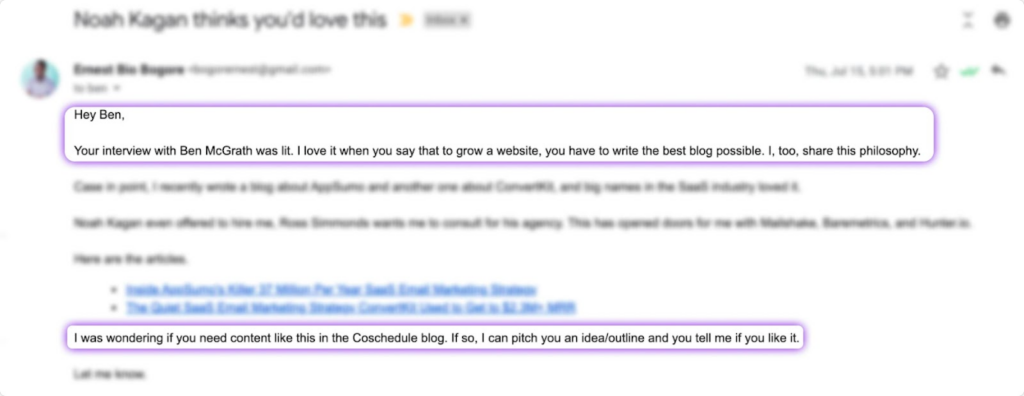
Here’s what he replied 1 hour later.
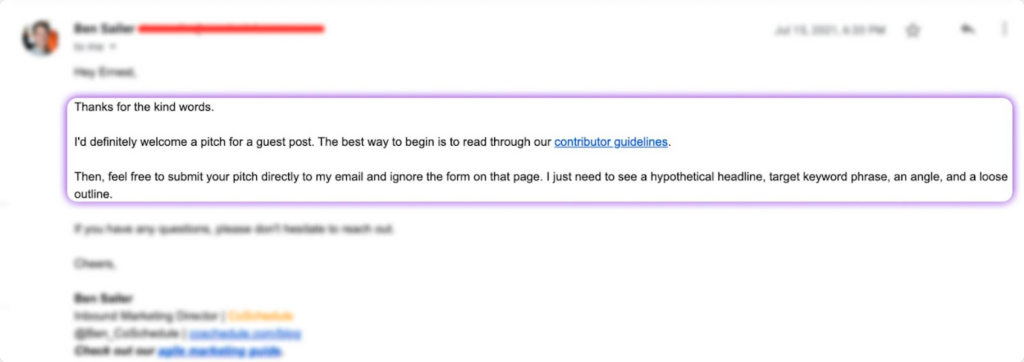
Note: Struggling to get replies or book meetings with prospects that fit in your ICP? We’ll help you get 6 SQLs or book 6 meetings with prospects that are ready to buy for only $999/month. Book a 15-minute consultation now.
Step 3: Bring it back to the matter and validate yourself
Now that you’ve made a connection, your goal is to bring it back to the matter and validate yourself.
This is where you get serious and start talking business. Ideally, whatever approach you use, you want your prospect to know the purpose of your outreach and what you are bringing to their table.
You can do this by mentioning the problem in a way that shows you understand what they’re facing or what could be improved in their current lifestyle:
- “I understand that {{this}} is an important issue for your company. Our {{XYZ}}…’’
- “Quick question, how do you feel about {{XYZ}}? We’ve had great success with our product and would love for you guys to try it out.”
Whatever approach you use, make sure that it explains why you’re reaching out and how your product or service can solve the reader’s problem or meet their needs.
Don’t assume that the reader already knows what you’re offering or how it can help them. Instead, be clear and concise about the value you’re offering.
Here’s an example where we used a case study to pitch a VP of Marketing at a Crypto company. Here’s how it turned out.
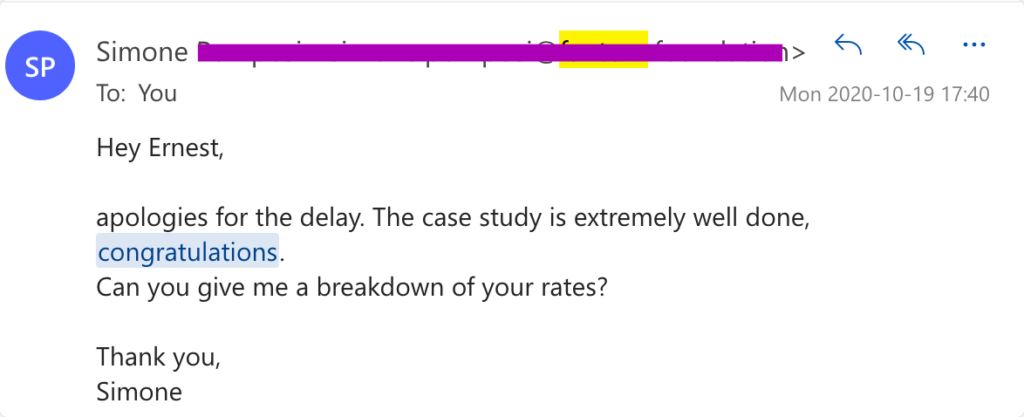
Step 4: Drill down on the prospect’s pain points
Now it’s time to drill down and offer value. You should be able to cite specific examples of how your product or service will help them overcome their pain point.
Mentioning their paint points is the best way to make your email valuable and your offer relevant to them.
So, start by looking at your prospect’s pain points and needs. Look at the challenges they face that your offer can help with.
Analyze their business goals or the lifestyle they are chasing and how your product or service fits into that.
From there, depending on the product you’re selling, you can find specific use cases of your product and offer that will be relevant to your prospect in your cold email strategy. From there, you can proceed to write the value section in your email body as follow:
- Use cases: Unique situations where your offering will be the most meaningful and relatable to your target audience. It covers their pain points or aligns with their business or lifestyle goals.
- Benefits: Your target audience can see how adopting your product will impact their life from reading the email body. The value you are bringing to their table or, simply, the lifestyle they will have after integrating your product or using your service.
- Examples: Real-life case scenario of your product in action or how it has done for someone with the same need and goals as your prospect.
Bullet points and numbered lists are a great way to write this part. It’ll also make your email more readable and easier to scan.
So, use them to highlight your product or service’s key features and benefits. This will help the reader quickly understand the value of what you’re offering and why they should be interested.
Here’s an example. In this cold email, we pitched a Head of Marketing at a B2B Marketing Agency and we focused on their specific pain point.
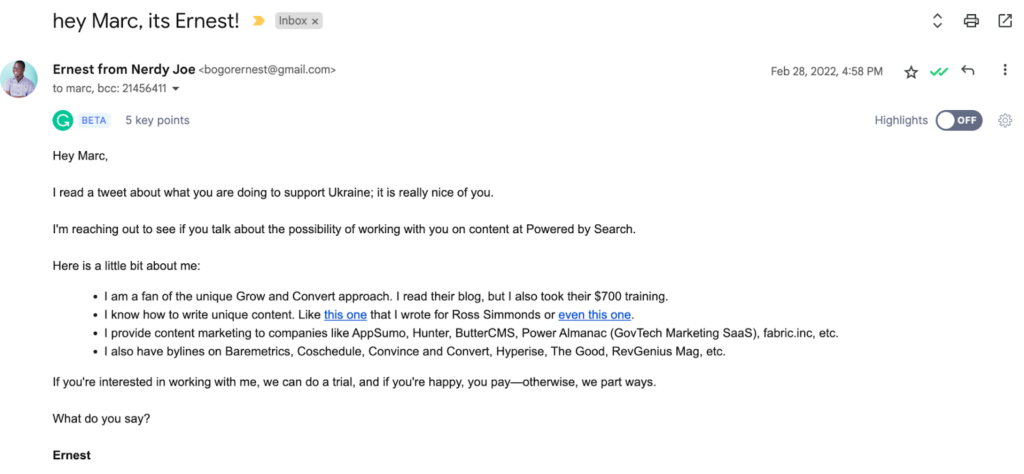
And here’s his reply.
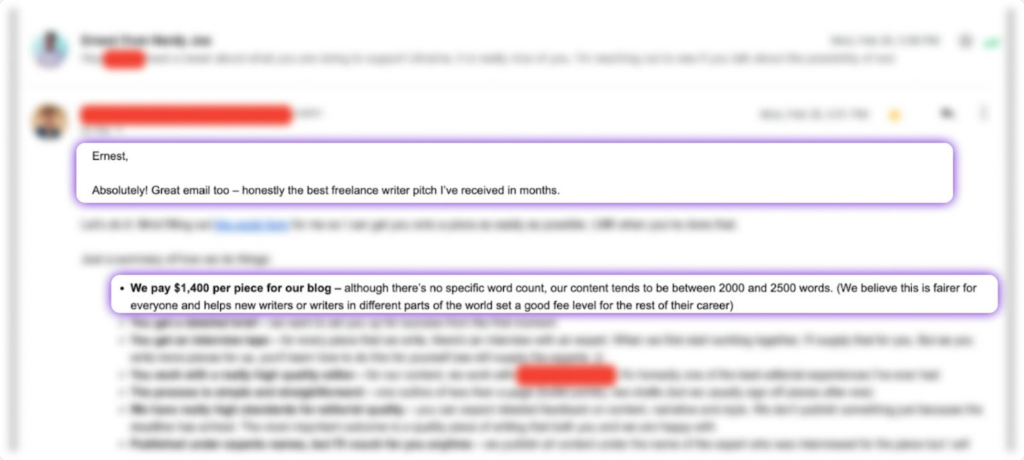
Step 5: Personalize the cold email message
A personalized cold email is the most effective. If you have been doing everything so far, your email should be personalized already.
Because from a personalized subject line, an icebreaker that’s specific and speaks to your prospect, and their pain points and mentions of use cases based on those and their goals, your email is up for excellent personalization already.
Now, you just need to bring it home with a few tactics. This boils down to manually adding a few personal touches to the cold email to make the statement that you are not just another marketer sending email bulk to a list of prospects.
Here is an excellent example of an email that’s specific and relevant to a single person.
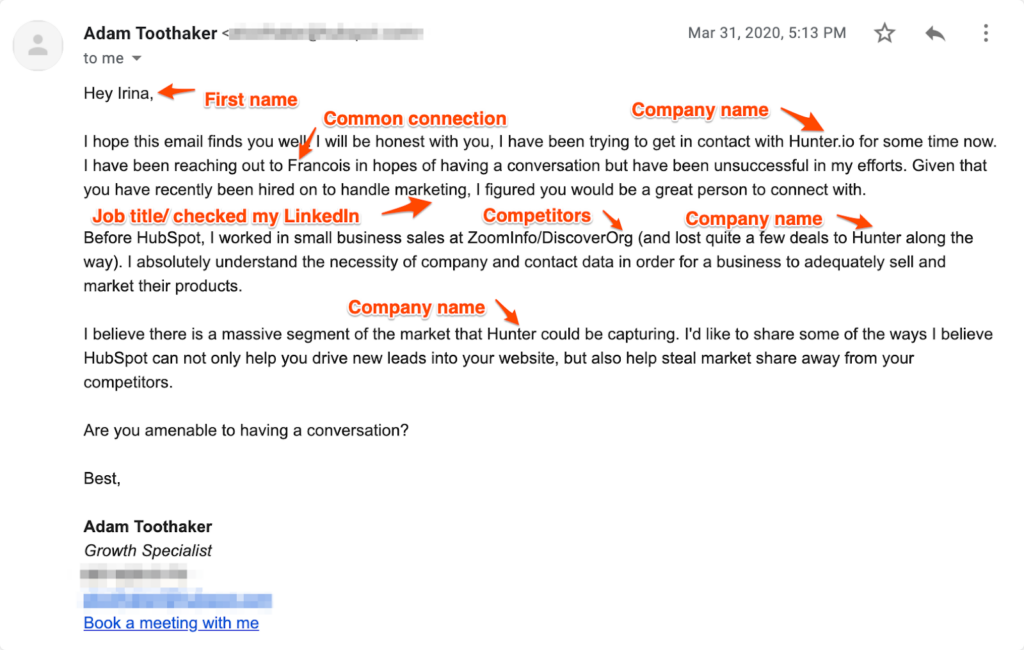
The idea here is to include a few personal elements about your recipients inside the email. In most cases, you can do it from your cold email software.
Here are a few things you can use in this context:
- Their company
- Their current job position
- Their competitors
- Their past positions
- Their previous companies
- Their first name
- A common connection
- Etcetera
Step 6: End with a great call to action
A call to action is a statement that tells the reader what you want them to do next. They help boost your reply rate and instruct the prospect on what to do next.
Also, since you are looking to sell something or connect in some way with the prospect through the cold email, it only makes sense to include a clear CTA in your cold email outreach message.
Depending on your goal, the right next step in your funnel or simply what you’re selling, this could be setting up a call to discuss the product further, visiting your website to learn more, or filling out a form to request a quote. Make it clear and easy for the reader to take the next step.
Here are some CTA examples you can use in your cold emails.
- Get 50% off now
- Learn more about {{XYZ}}
- Are you interested in {{your_offer}}?
- Will this work for you?
- Book your next appointment
- Start your free trial.
- Can you please put me in touch with the right person?
- Get results now
- Start now. Get results.
- Is this a priority issue you want to resolve?
Also, be proactive with the CTA, as it may give your prospect the extra kick they need to take action.
For example, when you ask them when they’re interested in a call, be sure to include a link they can use to access your calendar and set up the call easily. If you want them to take a step towards your brand, give them a preview, etc.
Step 7: Test and optimize
Once you’ve written your cold email, it’s a good idea to test it and see how it performs. Send it to a small group of people or people you work with and see how many of them open it and click on it.
Based on the results, you can make changes and try again. This process of testing and optimizing is basically A/B testing, and it can help you refine your email and improve its effectiveness.
Step 8: Follow up
It’s not uncommon for cold emails to go unanswered — especially if you target a busy person. If you don’t hear back from the reader after sending your cold email, it’s a good idea to follow up.
Following up on cold emails is important because it can increase your chances of getting a response and ultimately achieving your goals.
Some reasons to follow up on a cold email include:
- To remind the recipient of your email: If your initial email was lost or forgotten, a follow-up can serve as a reminder to win the prospect’s attention and get on their radar.
- To provide additional information: If you sent an initial email and the recipient expressed interest but asked for more information, a follow-up can provide the additional details they need to make a decision.
- To overcome objections or address concerns: If the recipient raised objections or had concerns about your initial email, a follow-up can provide further explanation or address those issues.
- To build a relationship: Even if the recipient is not interested in your initial offer, following up can help you establish a relationship and stay top of mind for future opportunities.
When following up on a cold email, it’s important to be respectful of the recipient’s time and to be clear about the purpose of your follow-up.
Here are some tips for following up effectively:
- Keep it short: Your follow-up email should be brief and to the point.
- Personalize the message: Add personal elements about the recipients and refer to specific details from your initial email to show that you’re paying attention and value their time.
- Offer value: Consider offering additional resources or information that may be useful to the recipient.
- Be patient: It’s important to give the recipient enough time to respond before following up. A good rule of thumb is to wait at least a week before sending a follow-up email.
- Use a clear subject line: A clear, concise subject line will help the recipient understand the purpose of your email and make it more likely that they will open and read it.
7 tips to improve your cold email and set yourself up for success
Here are a few tips to improve your cold email and set yourself up for success and close your prospect.
Don’t be aggressive in your cold email (offer or sales pitch)
As a sales rep or a marketer, whatever you sell through cold outreach, it’s generally not a good idea to be aggressive in your cold messages. And there are a couple of reasons why.
Firstly, being aggressive in a cold email can make it seem like you are just trying to sell something without considering the recipient’s needs or interests.
This can make your email feel impersonal and may lead the recipient to mark it as spam or ignore it altogether.
Also, if you come across as pushy or aggressive in your cold emails, it can damage your reputation and make it harder to establish relationships with potential clients or partners.
And lastly, being aggressive in a cold email is unlikely to lead to a successful outcome as it decreases your chances of success. Instead, it’s important to approach cold emailing with a focus on building genuine connections and offering value to the recipient.
It’s generally a better approach to be respectful and considerate in your cold emails, focusing on building relationships and offering value rather than trying to make a hard sell.
This can help you establish trust and credibility with the prospect and increase your chances of success.
Optimize your cold email for deliverability
Start by getting the technical stuff right before launching your cold email campaign. Technical elements such as SPF, DKIM, and DMARC can all hinder your cold email deliverability when not set up well.
Also, be sure to avoid email spam trigger words in your cold emails or subject lines. Always keep things simple and ensure your email copy doesn’t include too many images, HTML, or other content that can be seen as spam.
Get your cold email signature right
Your email signature and the way you sign off are also key elements that contribute to how your prospect feel about you when they’re done reading your cold emails.
Having a good subject line is great for a successful cold emails, but signing off the right helps ensure a brand recall and improve the reader’s experience. Here are some tips for getting your cold email signature right:
- Keep it simple: Your signature should be easy to read and not cluttered with too much information — especially since this is your first cold email campaign.
- Include your name and title: Make it clear who you are and what you do, as this will help the recipient understand your role and how you can potentially help them.
- Include your contact information: Make sure to include your email address, phone number, and any other relevant contact information, such as a LinkedIn profile or website.
- Use a professional font and layout: Choose a clean, professional font and layout for your signature to give a good impression.
- Be consistent: Use the same signature for all your cold emails to establish consistency and make it easy for the recipient to contact you as they know it’s the same email sender.
It’s also a good idea to review and update your signature periodically to ensure that it reflects your current position and contact information.
Avoid formal languages
You also need to avoid using formal language like “Dear” or “Ms.” If you use these opening line greetings, it might seem like you’re trying too hard to be professional—and that could make people uncomfortable.
It’s better if you can use normal names instead of titles when writing cold emails because it shows that there’s no need for formalities between yourself and your cold leads (you’re just talking directly with them).
Build rapport in the first sentence
The first sentence of your email should build rapport. This can be done by being friendly but not too familiar. You want to show that you’re a human being and not just some automated system sending out emails at random.
Close the email by thanking the reader
End the cold email by thanking the reader for their time and providing your contact information. This is a polite way to end the email and makes it easy for the reader to get in touch with you if they’re interested in learning more.
Keep the cold email brief and to the point.
No one wants to read a long, rambling email, especially when they don’t know you. Stick to the most important points and leave out any unnecessary details.
Aim for a cold email that’s around 200-300 words, or roughly the length of this paragraph.
20 cold email templates you can use for inspiration to write a cold email
Here are cold email templates that you can use as a starting point to come up with your own.
These templates are based on different angles you can take to write cold sales emails you can send your prospects.
Template 1: The Value Proposition cold email
Here you focus on highlighting the value that your software or tool product can provide to the recipient.
Subject line: {{Your product}} can help you {{benefit}}
Hi {{Name}},
I checked your LinkedIn profile and should say your work experience is very inspiring. I look forward to congratulating you on your second anniversary as {{position}} at {{company}}. Keep up the good work.
I wanted to reach out because I believe that {{your product}} could be a valuable addition to your business.
Our product helps {{target customers}} to {{achieve specific benefit}}. For example, one of our customers was able to {{specific benefit achieved}} after implementing our solution.
Another case {{specific benefit achieved}}
Another case {{specific benefit achieved}}
I’d love to schedule a call with you to discuss how {{your product}} could benefit your business.
Let me know if this is something you’d be interested in, and we can set a time that works for you.
Best,
{{Your Name}}
[your name]
Template 2: The Personalized Approach cold email
This cold email template focuses on making a connection with the recipient by personalizing the cold email to their specific needs or challenges.
The goal is to make the email relevant and compelling so that they open it, read, and take your desired action.
{{Your Name}}
Subject line: A solution for {{specific challenge faced by recipient}}
Hi {{first name}},
Congratulations on your new role as {{new and recent position}} of {{department}} at {{company name}}. You’re charting an impressive career path. Keep up the good work.
I noticed that your company is facing the challenge of {{specific challenge faced by recipient}}.
Companies in {{relevant industry/area}} have been using our {{tool name}} to solve {{specific challenge faced by recipient}}. So, I wanted to reach out and see if I could help.
Our product, {{Your product}}, is specifically designed to help companies like yours overcome this challenge by {{specific feature or benefit}}.
In fact, one of our customers was able to {{specific benefit achieved}} after implementing our solution.
Would you be interested in learning more about how {{Your SaaS product}} can help your business? I’d be happy to schedule a call to discuss this in more detail.
Best,
{{Your Name}}
[your name]
Template 3: The Testimonial or The Social Proof cold email
This cold email template focuses on using customer testimonials to demonstrate the effectiveness of your product.
Subject line: {{Product}} + {{parallel company}} = {{specific benefit}}
Hi {{first name}},
I read John Doe’s recommendation on your LinkedIn profile, and I must say, good job. You are the type of {{job title}} that every company dreams of. Keep up the good work.
I’m reaching out to share some information about our product, {{product name}}, and how it has helped businesses like yours achieve {{specific benefit}}.
One of our customers, {{Name of Customer}}, had this to say about their experience with our product: {{Include testimonial}}.
Here is their story.
{{problems they were facing}}
{{how they came across your solution}}
{{how your solution helped them}}
{{their new lifestyle}}
If you’re interested in learning more about how {{your product}} can benefit your business, I’d be happy to schedule a call to discuss this in more detail.
Let me know what you think.
Best,
{{Your name}}
Template 4: The Case Study cold email
This template focuses on using a case study to demonstrate the effectiveness of your SaaS product.
Subject line: How {{case study company}} {{specific benefit}}
Hi {{first name}},
It’s so great to see that you have accumulated all this experience over the years, helping so many companies to grow. Your career path is so impressive. Someone with your experience is a hero in my book. Keep up the good work.
Quick question. Have you ever wondered how {{company name}} have achieved {{specific benefit}}?
Well, that is our {{tool name}} at work. And we are here with {{case study}} to show you how they made it happen so you can copy it.
{{Include case study}}.
If you’re interested in learning more about how {{Your product}} can benefit your business, I’d be happy to schedule a call to discuss this in more detail.
Best,
{{Your name}}
Template 5: The Free Trial or Demo cold email
This template focuses on offering a free trial or demo of your product to the recipient in order to get them interested about it and hook them to buy.
Subject line: {{Your product}} – a free trial for you
Hi {{Name}},
I’m probably late to the party, but I still want to congratulate you on your fifth anniversary as the {{job position}} at {{company name}}. By the way, you’re charting an impressive career path. Keep up the good work.
I wanted to reach out and offer you the opportunity to try out our product, {{Your product}}, for free.
{{Your product}} is designed to help businesses like yours {{specific benefit}}. We believe in the value of our product and are confident that you’ll see the benefits as well.
That’s why we’re offering a free trial to give you the opportunity to see for yourself how it can help your business.
If you’re interested in learning more and taking advantage of this free trial offer, please let me know and I’d be happy to schedule a demo for you.
Best,
{{Your name}}
Template 6: The Exclusive Offer cold email
This cold email template focuses on making the recipient feel special by offering them an exclusive deal or offer.
Subject line: Exclusive offer for {{Company Name}} – {{Your SaaS product}}
Hi {{Name}},
I hope this email finds you well. I wanted to reach out and offer you an exclusive deal on our product, {{Your product}}.
As a valued customer of {{Company Name}}, we want to offer you a special discount on our product.
We’ve seen great success with companies like yours, and we’re confident it will be a valuable addition to your business.
If you’re interested in taking advantage of this exclusive offer, please let me know, and I’d be happy to provide you with more information.
Best,
{{Your Name}}
Template 7: The Referral cold email
This cold email example focuses on using a referral or introduction from a mutual connection to build credibility and establish a connection with the recipient.
Subject line: Introduction from {{Mutual Connection}} – {{Your SaaS product}}
Hi {{Name}},
It’s so great to see that you have accumulated all this experience over the years, helping so many companies to grow. Your career path is so impressive. Someone with your experience is a hero in my book. Keep up the good work.
So, I was recently introduced to {{Mutual Connection}}, and they mentioned that you might be interested in learning more about {{Your product}}.
Our product helps businesses like yours {{specific benefit}} and has been well received by companies in {{industry/vertical}}.
If you’re interested in learning more about how {{Your SaaS product}} can benefit your business, I’d be happy to schedule a call to discuss this in more detail.
Best,
{{Your Name}}
Template 8: The Limited Time Offer cold email
This template focuses on creating a sense of urgency by offering a limited time deal or promotion.
Subject line: Limited time offer – {{Your product}}
Hi {{Name}},
I just came across your LinkedIn profile, and I must say that you have an impressive career path. But I literally became a fan as I saw the many recommendations and awards you receive. Keep up the good work.
I wanted to let you know about a limited-time offer we have on our product, {{Your product}}.
Our product helps businesses like {{competitor 1}} and {{competitor 2}} with {{specific benefit}}, and we’re offering a special promotion for a limited time.
This offer includes {{details of promotion}} and is only available for the next {{time frame}}.
If you’re interested in taking advantage of this limited-time offer and learning more about how {{Your product}} can benefit your business, let me know, and I’d be happy to schedule a call to discuss in more detail.
Best,
{{Your Name}}
Template 9: The Industry Expert cold email
This template focuses on positioning yourself or your company as an industry expert and offering valuable insights or resources to the recipient.
Subject line: {{Industry}} insights from {{Your SaaS product}}
Hi {{Name}},
I saw that you speak five languages. That’s pretty impressive. I’m still struggling with the third (Mandarin). I’m a big fan. BTW, it’s great to see how people recommend you on LinkedIn. Keep up the good work.
I wanted to reach out and share some valuable insights and resources related to the {{industry}} industry.
At {{Your company}}, we’ve helped numerous businesses in {{industry}} achieve {{specific benefit}} and have learned a lot about what works and what doesn’t.
We believe that sharing our knowledge and experience can help other businesses in the industry succeed as well.
If you’re interested in learning more about the {{industry}} industry and how {{Your product}} can help your business, I’d be happy to schedule a call to discuss this in more detail.
I can also provide you with some useful resources and insights that we’ve developed based on our experience in the industry.
Let me know if you’d be interested in exploring this further.
Best,
{{Your Name}}
Template 10: The “Just Checking In” Follow-Up cold email
This template can be used for following up on a previous email or touchpoint with the recipient.
Subject line: Just checking in – {{Your SaaS product}}
Hi {{Name}},
I hope this email finds you well.
I wanted to follow up on the email I sent a few weeks ago about {{Your product}} and see if you had any further questions or if you’d like to schedule a call to discuss this in more detail.
Our product has helped numerous businesses like yours achieve {{specific benefit}}, and we’d love the opportunity to show you how it can benefit your business as well.
If you’re still interested in learning more, please let me know, and we can schedule a call at your convenience.
Best,
{{Your Name}}
Template 11: The “New Product Launch” Announcement cold email
This template can be used to announce the launch of a new eCommerce product and generate interest from potential customers.
Subject line: {{eCommerce Product}} is now available – {{Limited Time Offer}}
Hi {{Name}},
I just looked through your LinkedIn profile and realized that you didn’t waste any time after college and took a job as {{position}} at {{company}}. Today, you have accumulated over 20 years of experience and are making an incredible story. Way to go, man; keep up the good work.
BTW, I wanted to reach out and let you know about the launch of our new eCommerce product, {{Product}}.
{{Product}} is designed to {{specific benefit}}, and we believe it will be a valuable addition to your {{online store/business}}.
As a special launch offer, we’re offering {{limited time promotion}} for the first {{time frame}} after launch.
If you’re interested in learning more about {{eCommerce Product}} and taking advantage of this limited-time offer, please let me know, and I’d be happy to provide you with more information.
Best,
{{Your Name}}
Template 12: The “Best-Selling” Product cold email
This template focuses on highlighting the popularity and success of a specific eCommerce product.
Subject line: Our best-selling {{eCommerce Product}} – {{Limited Time Offer}}
Hi {{Name}},
I’ve just been through your LinkedIn profile and must say I love the great job your company is doing in the {{industry}} industry. Kudos to you and the amazing team at {{company name}}.
I wanted to reach out and let you know about our best-selling eCommerce product, {{Product}}.
{{Product}} has been extremely popular with customers and has consistently been one of our top-selling products.
It’s designed to {{specific benefit}}, and we believe it will be a valuable addition to your {{online store/business}}.
As a special offer, we’re offering {{limited time promotion}} for the next {{time frame}}.
If you’re interested in learning more about {{Product}} and taking advantage of this offer, let me know, and I’d be happy to provide you with more information.
Best,
{{Your Name}}
Template 13: The “Exclusive Offer” for VIP Customers cold email
This template focuses on making the recipient feel special by offering them an exclusive deal or offer.
Subject line: Only for our VIPs – {{Ecommerce Product}}
Hi {{Name}},
Excited to witness you celebrate your first year at {{company name}}. You are writing a great career story. Keep up the good work.
I wanted to reach out and offer you an exclusive deal on our product, {{ Product}}.
As a valued customer of {{Company Name}}, we want to offer you a special discount on {{Product}}.
It’s designed to {{specific benefit}}, and we believe it will be a valuable addition to your {{online store/business}}.
If you’re interested in taking advantage of this exclusive offer, let me know, and I’d be happy to provide you with more information.
Best,
{{Your Name}}
Template 14: The “Customer Testimonial” Cold Email
This template focuses on using customer testimonials to demonstrate the effectiveness of your ecommerce product.
Subject line: {{Ecommerce Product}} – as recommended by {{Name of Customer}}
Hi {{Name}},
Congratulations on your recent involvement with {{company name}} on its 100th anniversary. Hope you played the piano as well.
I wanted to reach out and share some information about our product, {{Product}}, and how it has helped customers like {{Customer’s company name}}.
{{Name of Customer}} had this to say about their experience with {{Product}}:
{{Include testimonial}}.
If you’re interested in learning more about {{Product}} and how it can benefit your {{online store/business}}, I’d be happy to provide you with more information.
Best,
{{Your Name}}
Template 15: Solve a problem
Using this cold email format will help you identify a problem that your recipient may be facing, and offer a solution through your product or service.
Subject line: A solution to {{Recipient’s Industry}} challenges
Hello {{First name}},
I just read one of the posts you shared on LinkedIn, and I have to say, I love what you guys are doing at the company. Keep empowering brands and inspiring them to make their customers happy with your solutions. Kudos to you.
As someone who works in {{Recipient’s Industry}}, I’m sure you face a variety of challenges on a daily basis. One challenge that I know many companies in your industry struggle with is {{Problem}}.
At {{Company}}, we specialize in helping businesses like yours overcome this challenge through our {{Product/Service}}. Our solution has helped numerous companies in your industry {{Benefits of Product/Service}}.
I’d love the opportunity to discuss how our product/service could potentially benefit your business and solve the challenge of {{Problem}}.
Could we schedule a quick call to talk more about it?
Best regards,
{{Your Name}}
Template 16: Build rapport and offer
Find common ground or shared interests with your recipient, and use this to establish a connection and build rapport.
Subject line: {{Shared Interest}} and {{Your SaaS Product}}
Hi {{First name}},
I came across your company while doing some research and noticed that we both have a shared interest in {{Shared Interest}}.
I’m always looking for ways to connect with like-minded professionals and thought this might be a good opportunity to introduce myself.
I’m the CEO of {{Your Company}}, a SaaS company that helps businesses {{What Your SaaS Does}}.
We’ve been able to help numerous companies in {{Industry}} improve their {{Key Performance Indicator}}, and I was wondering if you’d be interested in learning more about how our product could potentially benefit your business.
I’m happy to schedule a quick call to discuss this further and see if there’s a fit. Let me know if you’d be interested in chatting.
Best regards,
{{Your Name}}
Template 17: Ask for advice and introduce your product
Show that you value your recipient’s expertise by asking for their advice or guidance on a specific topic.
Subject line: Seeking {{Recipient’s Area of Expertise}} guidance
Hello {{First namet}},
I recently came across your company and was impressed by the {{Positive Attribute}} of your work in the field of {{Prospect’s Area of Expertise}}.
As someone who is also passionate about {{Topic}}, I was wondering if I could ask for a bit of your advice.
We’re currently working on a project related to {{Topic}}, and I’d love to get your perspective on it. I know you’re an expert in this field, and any guidance you could provide would be greatly appreciated.
I’d also be happy to introduce you to our product if you’re interested in learning more about what we do.
Please let me know if you’d be open to a quick call to discuss this further.
Best regards,
{{Your Name}}
Template 18: Invite to a sales event
Invite your recipient to attend an event or webinar that you think they would be interested in.
Subject line: Invitation to {{Event Name}}
Hi {{First name}},
I recently visited your company’s site. I was impressed by your work in the {{industry of the recipient}}.
As someone who is also passionate about {{Topic}}, I thought you might be interested in attending a special event we’re hosting.
On {{Date}}, we’re hosting a {{Event Type}} called {{Event Name}} that will cover {{Topic of Event}}.
We’ll be featuring expert speakers from {{Industry}} and {{Industry}}, as well as showcasing some of the latest trends and best practices in {{Topic}}.
I think this would be a valuable opportunity for you to learn from industry leaders and connect with like-minded professionals. I’d love for you to join us for this exciting event.
Let me know if you’re interested, and I’ll send you more information about how to register.
Best regards,
{{Your Name}}
Template 19: Offer a sample to try out
If you have a product or service, consider offering a free service or sample to give your recipient a chance to try it out.
Subject line: {{Free Service/Sample}} for {{Recipient’s Company}}
Hey {{First name}},
Congratulations on your success in joining the Carbon Ecosystem. This is a great step forward. Congratulations to the entire team at {{company name}}. Keep up the good work.
As someone who works in {{Prospect’s Industry}}, I’m sure you’re always looking for ways to improve {{xyz}} in your business.
That’s why I’m introducing you to {{Your Company}}, a {{Type of Company}} that helps businesses like yours {{What Your Company Does}}.
We’ve had great success helping companies in {{Industry}} improve their {{Key Performance Indicator}}, and I think we could potentially do the same for your business.
That’s why I’d like to offer you a free {{Service/Sample}} of our product/service. This will give you a chance to try it out and see how it can benefit your business.
If you’re interested in taking advantage of this offer, let me know, and I’ll be happy to provide you with more information.
Best regards,
{{Your Name}}
Template 20: The “personal story” cold email
If you want to share a personal story or experience that relates to your product or service and how it has helped you or someone you know, this is the combo of the right cold email template and compelling subject line that you need to get prospects interested.
Subject line: “Personal Story: How {{Product}} Changed My Life”
Hi {{First name}},
Congrats on your new job at {{company name}}. It’s cliché to say it, but what you have accomplished in 3 years {{company name}} is unbelievable. I look up to you.
I wanted to share a personal story with you about how my product has helped me and those around me.
As a {{profession}}, I often find myself dealing with long hours and high-stress levels. My product, {{Product}}, has been a lifesaver for me in managing my daily tasks and keeping my stress levels in check.
Not only has it helped me, but I’ve also had multiple colleagues and friends who have experienced the same benefits.
One friend, who is a single mom, has mentioned how much easier it is for her to manage her household and work responsibilities with the help of my product.
I truly believe that {{Product}} can make a difference in anyone’s life, and I hope you will give it a try. I’m confident it can help you as much as it has helped me and those I know.
Thank you for considering my product
Sincerely,
{{Your Name}}
Key takeaways
- In your cold email, the first paragraph should be compelling, grab your reader’s attention, and set up what comes next.
The second should build on that premise by adding more value or information that makes it worth their time to continue reading your message (or click through). - You also need to understand what makes your brand unique and capitalize on that in your first few sentences so people know what they’re getting into when they open your email.
- Remember, your cold email needs to be highly personalized and focused on one specific person. It should not be generic. Personalized cold emails always win. You should also include a call-to-action in your message that clearly tells the recipient what they need to do after reading your cold email.
Note: Struggling to fill your calendar with sales-qualified meetings? For $799/month, we’ll book 5 meetings with sales-ready prospects for you every month. Book a consultation call now.
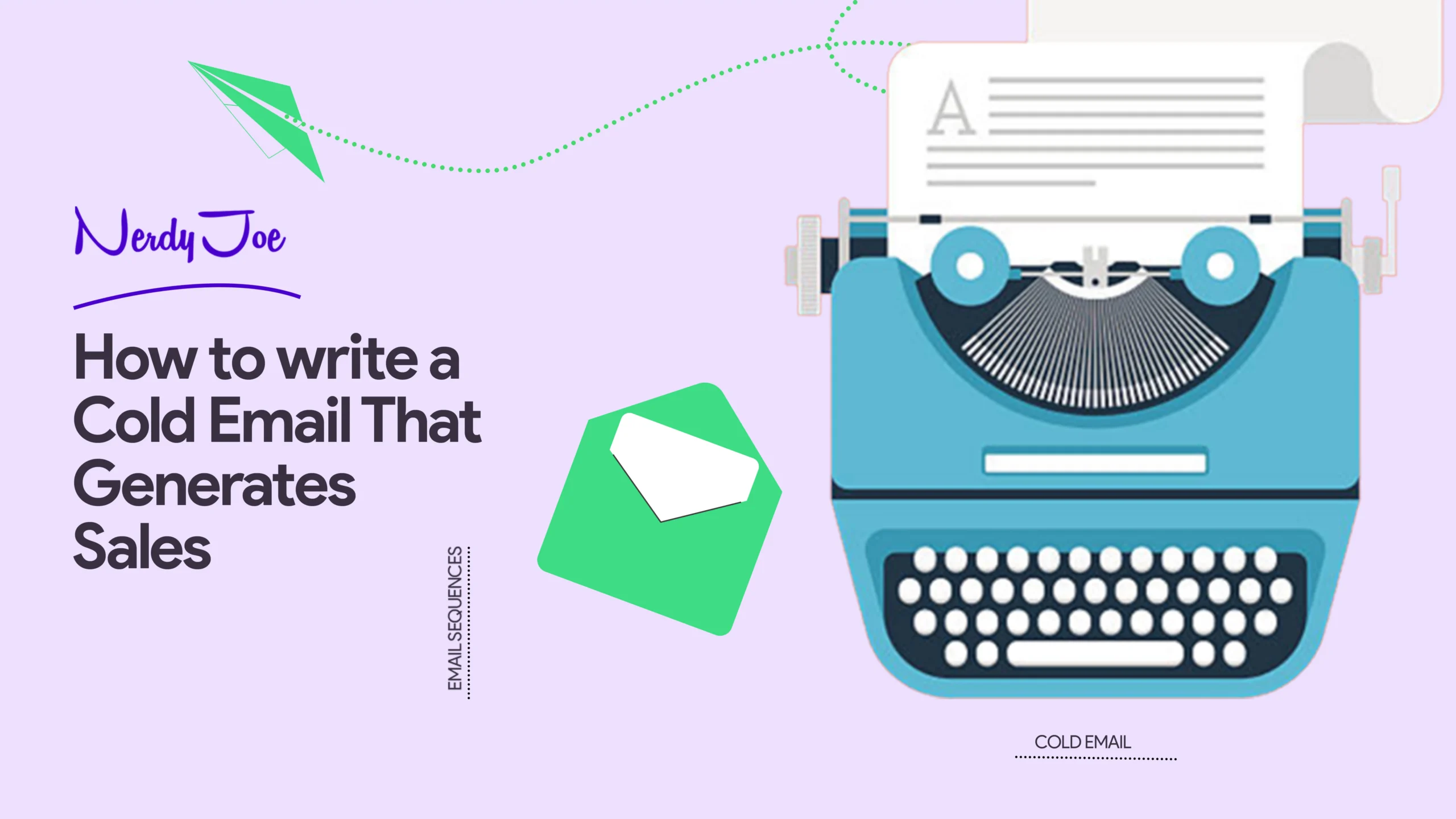
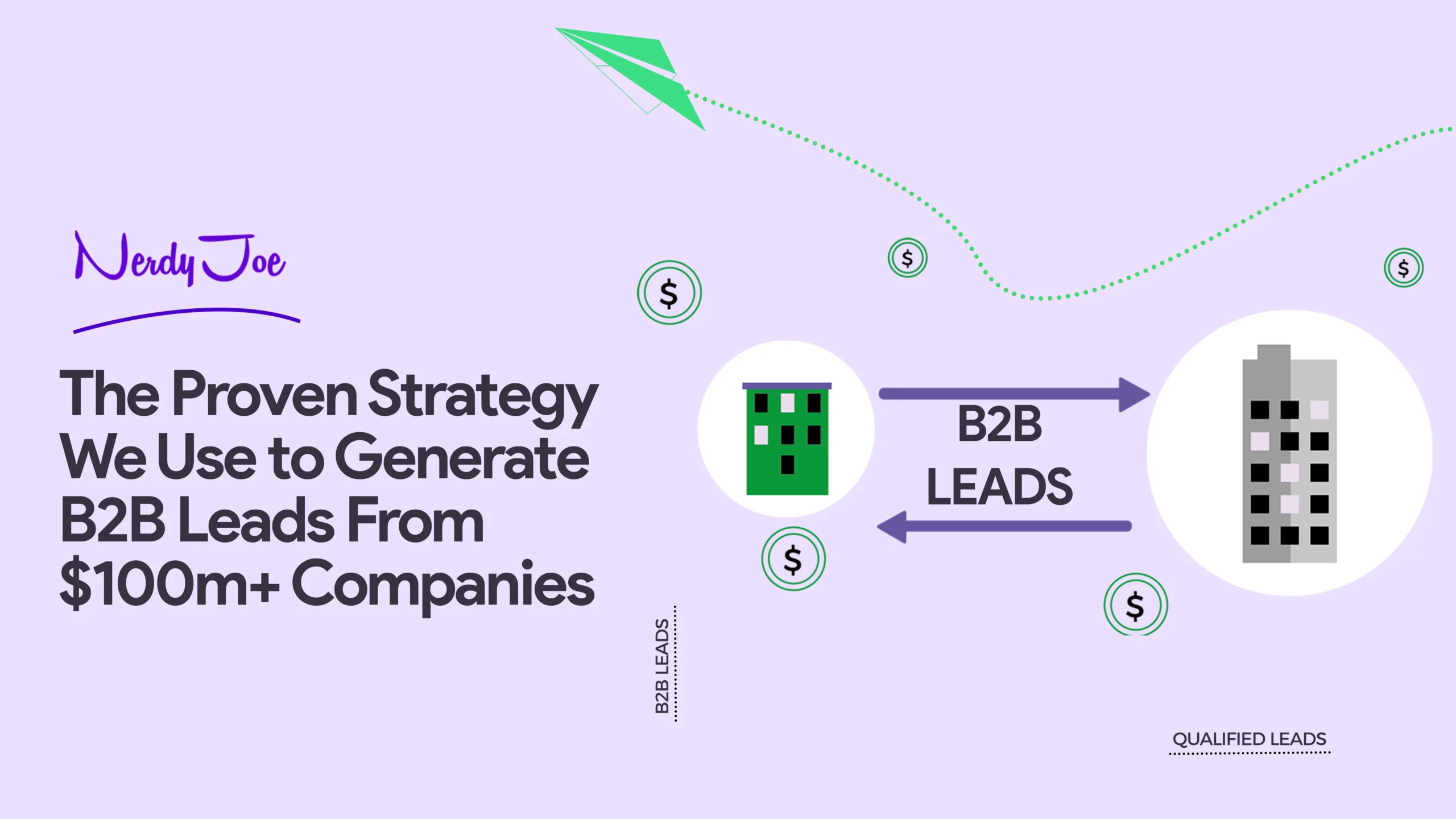
![How to Generate B2B Leads With Cold Outreach [Case Study]](https://nerdyjoe.com/wp-content/uploads/2024/06/1669218674-artboard-1-copie-4-3x-1-scaled.webp)
